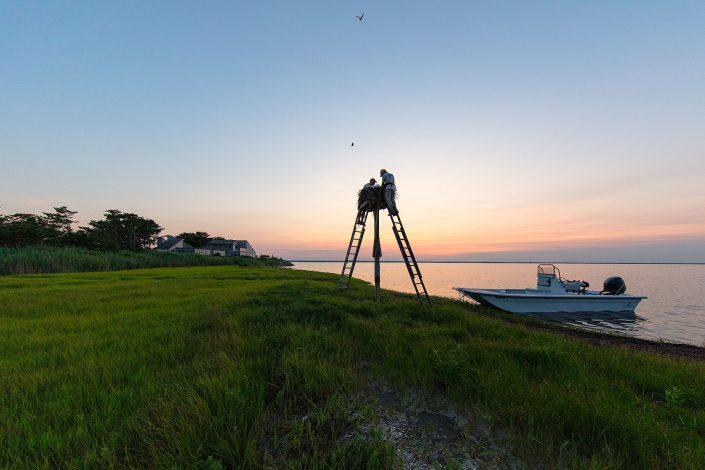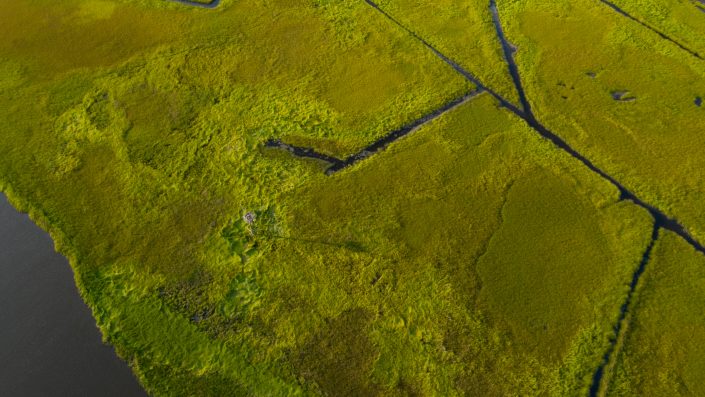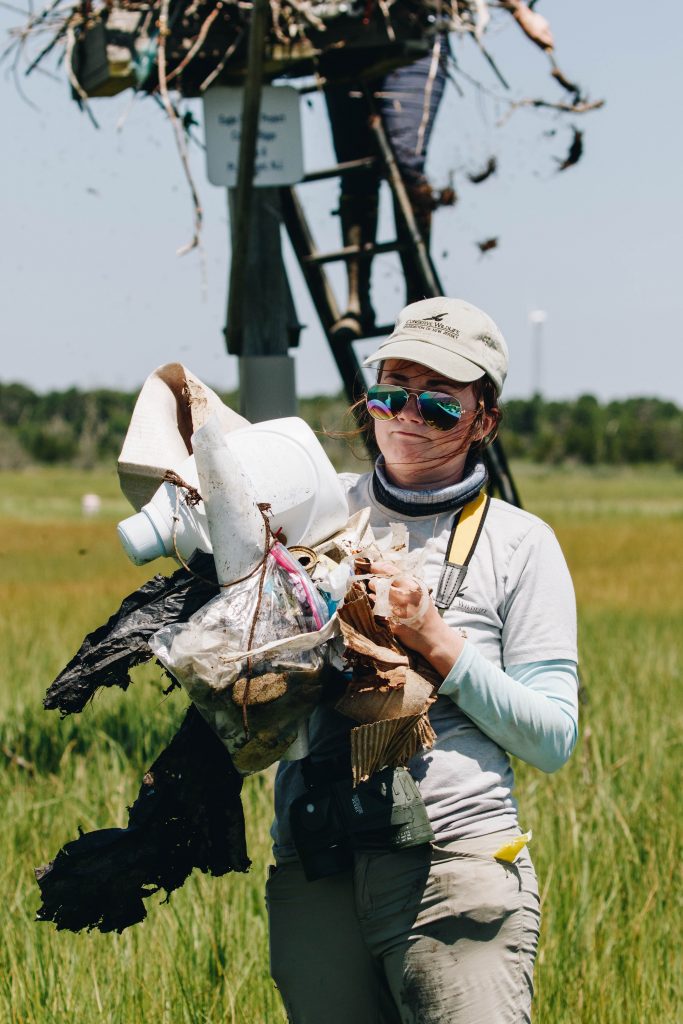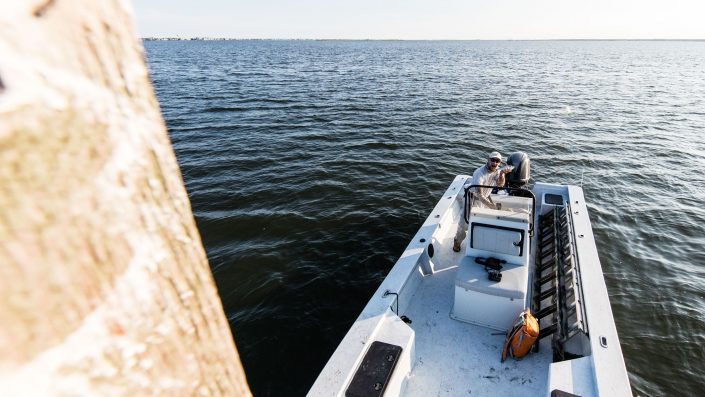Ospreys Continue to Thrive in New Jersey
Results from 2019 Osprey Nest Surveys highlight another productive year.
by Ben Wurst, Habitat Program Manager

Surveys of osprey nests in New Jersey have occurred annually for the past forty five years. They are conducted to help determine the overall size and health of the population. The first aerial survey over Barnegat Bay counted only five active nests. Ten years earlier there had been over 50. The combined effects of DDT and habitat loss had taken their toll. No osprey nests were productive and the population at risk of being extirpated from the state.
“In 1974 there were only five active osprey nests on Barnegat Bay. Today there are approximately one hundred and fifty.”
After ospreys were listed as endangered an innovative effort to transplant viable eggs from the Chesapeake Bay to Barnegat Bay began. In addition, to help replace natural nest sites that were lost to development, man-made nest platforms were designed and installed away from human disturbance. Slowly osprey pairs became productive thanks to the die hard effort of State biologists like Pete McLain, Kathy Clark and many volunteers and partners. It’s encouraging for us to look back to see how far we’ve come in the statewide recovery of ospreys in New Jersey.
Surveys of active osprey nests occur during mid-summer, in late June and early July, when young are highly visible but not able to fly or leave their nest. Specially trained volunteers survey some of the most densely populated colonies of ospreys from Sandy Hook to Cape May and along the Delaware Bay to Salem. The majority of nests are accessed by boat and surveyed using a ladder, mirror on an extension pole or using optics. Data collected during these surveys include nest activity, number of eggs or young, age of the young, and whether or not the nest contains plastic. If certain conditions are met, young are banded for future tracking with USGS aluminum bird bands. Also noted is the condition of the nest platform and whether it needs any maintenance or repairs.
Since 2013, we have relied on sightings from the public on nest activity throughout the state using www.osprey-watch.org. All known osprey nests in New Jersey are mapped online on Osprey Watch. Osprey Watch is a global osprey watching community which is focused on using data to link the health of ospreys and the overall quality of the environment in which they live. As stated by Osprey Watch, their mission is “to collect information on a large enough spatial scale to be useful in addressing three of the most pressing issues facing aquatic ecosystems including global climate change, depletion of fish stocks, and environmental contaminants.” In New Jersey obtaining sightings from citizen scientists using Osprey Watch is critical to reach nests that are not covered by our ground surveys by boat. Last year a total of 80 occupied nests was reported in New Jersey, which was the most ever since we started partnering with Osprey Watch.

Results from the last years’ surveys have been published in the 2019 New Jersey Osprey Project Report. Data collected during the surveys indicate that ospreys continue to thrive in New Jersey. Overall, a total of 669 occupied nests were recorded. A total of 932 young were produced from 488 active nests. The productivity rate, which is a measure of the health of the population, was slightly more than the previous three years, at 1.91 young/active nest. Around 30% of young were banded for future tracking, including 68 with red auxiliary bands as part of Project RedBand, our re-sighting project on Barnegat Bay.

We continue to research the use of sUAS (small unmanned aerial system) or drones to survey osprey nests. Each year we survey around a half dozen nests using a sUAS to determine how the birds react when flying over an active nest. So far our data has shown that the birds are not affected by the sUAS when the operator is outside of their nesting territory and it remains at a high enough altitude so that the birds do not react. Our goal is to use sUAS to survey nests that are too high to climb or hard to access by boat. It’s important to note that if you own a drone, you should not use it to obtain a better view of any wildlife, including ospreys. Drones can be very disruptive to birds and if you get too close, then those birds could destroy your expensive toy. If you’d like to read more, here is a great story that features our work.

As many people know, plastics in the environment are becoming a global crisis. It is no surprise that ospreys collect and use plastics in their nests. Plastic marine debris collects in wrack lines and high marsh areas — where ospreys collect natural nesting material. Adults and their young are particularly at risk of becoming entangled, which usually requires human intervention for them to survive. To help prevent ospreys from becoming entangled, we remove all plastic marine debris from nests and the surrounding habitat. This year we started to keep track of the occurrence of plastics in nests and of our volunteers who reported it, we found that around 40% of nests contained some form of plastic marine debris. At the end of each survey, we are often overwhelmed with the amount of plastic that we collect…

In summary, our data shows that ospreys had a productive year in 2019 with 488 pairs that produced 932 young. Over the past twenty years the average statewide reproductive rate has steadily increased while the population growth rate has steadily decreased. The availability of prey does not appear to have limited the growth of the population; however, global fish stocks are expected to decline along with biodiversity. The use of plastics is also expected to increase in the coming decades, so we’re concerned about their future impact on ospreys. Climate change will only exacerbate these threats to ospreys, so future monitoring is critical to the long term stability of the state population. Ospreys continue to indicate that the overall quality of our environment, especially along the coast, has improved significantly over time.
Thank you to all of our volunteers and donors who support this project!
- Read the full results in the 2019 New Jersey Osprey Project Report
- Learn more about our Osprey Conservation Project
- Donate to support our work with ospreys!
- For media inquires and photos – contact Ben Wurst



















Discover more from Conserve Wildlife Foundation of NJ
Subscribe to get the latest posts sent to your email.